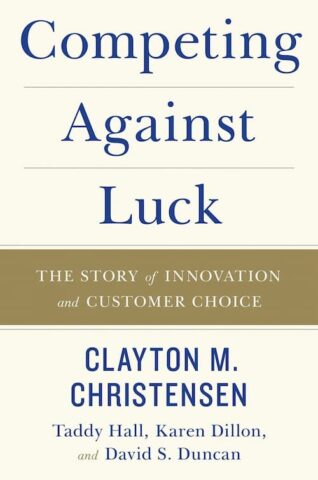The Jobs-to-Be-Done framework has been a boon to my business and the businesses I work with daily.
As a business strategist with nearly two decades of experience helping brands online and offline, one of the most disheartening occurrences I experience is telling business owners their ideas are unlikely to be (near) as successful as they’d hope. Often this is a result of the business owner understanding (only) their product or service while having little understanding of the marketplace or vertical they compete in. Simply put, an inability, or unwillingness, to climb into the minds of prospects and customers dooms them.
“It’s not enough to know your business,” I often say. “You must also understand the business, as in the business sector or vertical you compete in.”
Jobs to be done framework provides a tactical and strategic playbook for brands of all sizes.
Competing Against Luck: The Story of Innovation and Customer Choice, by the late Harvard Business School professor Clayton Christensen, provided business owners and marketers with a great playbook to help flatten the learning curve for creating products and services their intended audiences would crave and happily purchase. (The book was co-authored by Karen Dillon, Taddy Hall, and David S. Duncan.)

The book created a shift in my thinking, one where I focused less on the options available to customers and more on what goals any one customer had at a specific point in time. That is, instead of thinking of customers seeking out a product or service based on the latter’s features and ability to meet the customer’s goals, I now began the process by asking myself three questions, all focused on the customer:
- “What problems are they trying to solve?”
- “Whose product or service have they used—or hired—to solve this problem in the past?”
- “If none of the available products existed, what would they desire in the ideal product or service to meet their needs?”
I went all in on leading with customers’ first, which is what the book makes clear should be the goal for every business.
“What they really need to home in on is the progress that the customer is trying to make in a given circumstance—what the customer hopes to accomplish. This is what we’ve come to call the job to be done.“
I first encountered the Jobs To Be Done (JTBD) framework in How Will You Measure Your Life, a 2012 book by Christensen, Dillon and James Allworth. The book and the theory it put forth helped me to more clearly see something I couldn’t crystallize or distill very well on my own: Innovation alone is not the surest way to success. In fact, it can be an albatross for brands who create innovative products customers neither want, need, nor will pay for.
What jobs are customers hiring your product or service for?
What’s needed for brands of all sizes is an understanding of exactly what the prospect is trying to accomplish (JTBD), and that can only be discerned through careful study and analysis. I use the word “careful” with intention: Prospects and customers often don’t have a clear view of what they are trying to accomplish as it relates to your product. But what they can illuminate are the thoughts and feelings they experience as they search for and/or use a product or service intended to solve, or at least help them with, their needs/issues.
As a business owner, this can be invaluable at preventing you from going down expensive, time-consuming rabbit holes. I use the JTBD framework extensively in my work; it’s saved me and my clients innumerable headaches and lots of money. For example, years ago I advised a local franchisee wondering why the visits to her main location were so low given the popularity of the business and its seemingly ideal location.
The assumption was that the location was too small. But by employing the JTBD framework, we realized we’d misplaced our focus all along. The so-called ideal location was actually an impediment, since traffic patterns nearby meant customers—most of them women with kids in strollers—were never going to see the location as viable for their needs: a hassle-free lunch spot.
Were it not for employing Christensen’s Jobs to Be Done theory, the executive team would likely have approved a plan to make the current location larger. Instead, we found a spot for a new location and made sure it offered valet parking and a covered patio. Even though this location is 20% smaller than the main business, it does 30% more business, making it one of the top grossing franchises of its type in the state.
Jobs to Be Done has changed the way I approach work as a consultant and business coach. It’s also helped numerous clients, prospects and people I talk daily to informally develop a more holistic approach to growing their businesses.
Have you used the JTBD framework in your business?





